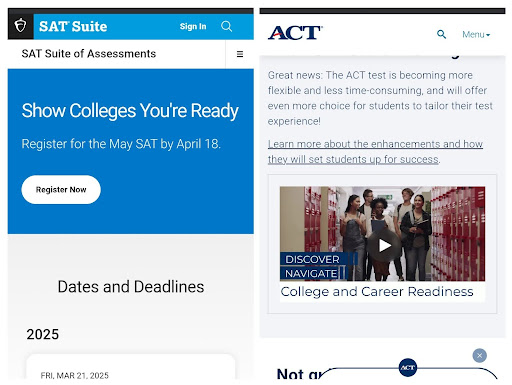Test scores have historically been an important part of college applications. Even though they were made optional during Covid-19 years, some colleges are making it mandatory again. The Scholastic Aptitude Test (SAT) and the American College Test (ACT) are the two tests students can choose from.
Most students take both tests at least once, and then choose one to retake and increase their score. They have similar elements, but are different enough that students clearly prefer one over the other.
“I did both the PSAT and the Pre-ACT, and I did better on the Pre-ACT… I felt like it was easier,” said Lillian Hogg, junior. Hogg chose to take the ACT.
“[I like] the SAT because you’re given more time per question,” said Sam Brown, senior. Brown took the ACT twice and the SAT three times.
The SAT has two different sections: Reading and Math. Comparatively, the ACT has four sections–English, Math, Reading, and Science.
“I liked [the ACT] because it had the science section… I didn’t really like the grammar section,” said Brooke Connelly, senior. Connelly took the ACT twice.
Aside from the test’s material being different, the format of the tests is different.
On the ACT, Students have 45 minutes to complete the English section, 60 minutes for Math, and 35 minutes for both reading and science.
On the SAT, each section consists of two “modules”, with there being about 32-35 minutes to complete each.
“I didn’t like how the ACT felt so fast. I felt rushed on every section,” said Zhang.
“Dislike the time on the math section [of the SAT]… after you complete the first part of it the second part’s usually a lot harder,” said Brown.
The number of questions differs from test to test as well.
On the SAT, there are 54 questions in the reading section, and 44 questions on the math section.
On the ACT, the English section has 75 questions, the Math section has 60 questions, and the Reading and Science sections both have 40 questions.
Preparing for the tests is very important for receiving good scores. ACT.org and CollegeBoard.org offer practice tests and helpful videos to students who choose to take the ACT or SAT, respectively. Tangible review guides are also available for those who want to purchase them.
“I did a lot of practice tests, and I reviewed the concepts,” said Jovin Zhang, junior. Zhang took both the ACT and the SAT.
“Normally I’ll either go on Bluebook and go over the tests they have there. Khan Academy and Princeton Review are also great resources,” said Brown.
“The night before I looked at some practice problems,” said Hogg.
With either test, a tool called superscoring is available to those who take the test multiple times. Superscoring allows students to take their highest scores from individual sections on the test, and combine them for the best possible composite score.
This can help boost the students’ test scores if they decide to submit them to colleges. Both Brown and Connelly took the tests several times and submitted their super scores to colleges.
The SAT and ACT are good tools to help students get into college, even if they are rather lengthy tests. They both have their benefits and their drawbacks, but they’re different enough students can feel more confident with one or the other.


Leave a Reply